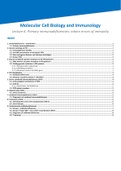Class notes
Lecture 6. Immune deficiencies (AM_470656)
- Course
- Institution
- Book
Information on etiology, and how to identify and classify them. Severe combined immunodeficiencies (SCID), atypical leaky SCID, combined immunodeficiencies diagnosis and treatment of SCID. Antibody immunodeficiencies.
[Show more]




